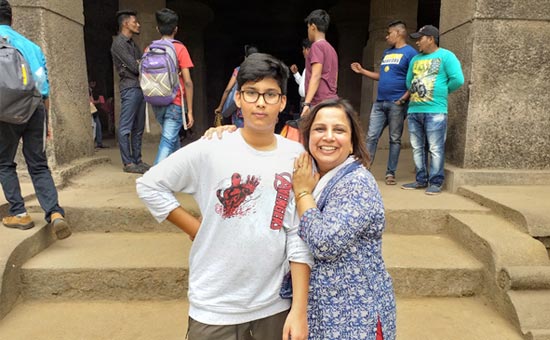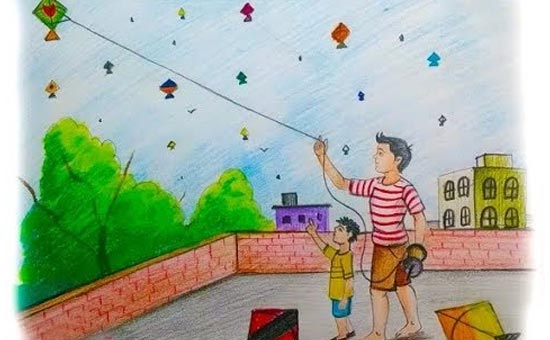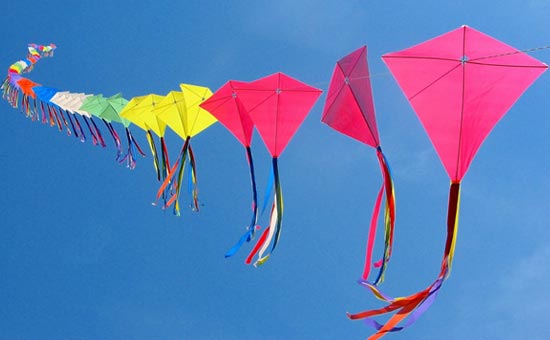- This article starts
with the festival of Makar Sanskranti and the tradition of kite-flying. Next it
relates the learnings from kite-flying with day to day living.
My thirteen year old
nephew Ravi, who studies in Class VIII, visited us during recent winter break
in December. While we were discussing his studies & school schedule, he
promptly said that would have very few holidays in the first quarter of 2020.
He was upset that he would be in school on January 14, writing an exam and so cannot
bunk that day.
I got curious and
asked why he wanted a holiday on January 14. He smirked and then laughed saying
it is the day when men & women of all ages are on their terraces flying
kites. He began to share memories of his kite flying experiences with friends
and family in the yester years.
 Author with
nephew.
Author with
nephew.
January 14 is celebrated as “Makar Sankranti”, also known as Uttarayan in India. Makar Sankranti
is also celebrated as the harvest festival
and marks the arrival of spring.
The day is synonymous with kite flying.
The time is thus spent socializing and family get-together, taking care of the cattle, celebrating around bonfires and flying kites. In fact a whole lot of people fly kites almost through the month….and in some parts of our country kite flying competitions are held, esp. in Gujarat.
Flying kites, preparing
traditional sweets (laddoos) with jaggery and sesame seeds and taking holy dip
in rivers form an integral part of this festival as is meeting with loved ones
and offering sweets.
Uttarayan, the six month
period between Makar Sankranti and Karka Sankranti (the day that marks the
movement of the sun into Karka rashi) marks the northward movement of the earth
in the celestial sphere. People continue with their celebrations during
Uttarayan as colourful kites adorn the sky. However, much like all other
traditions, there is a reason why people fly kites during Makar Sankranti and
in the days that follow the festival.
Traditionally, it was believed that winter
brought in a lot of germs and caused illness and flu. Thus, a huge number of
people would turn up during Makar Sankranti and in the following months to bask
in the early morning sun, hoping to get rid of bacteria and fly kites too. The
act of flying kites was said to have been initiated to make this act more
exciting.
Of course, the symbolism of kites flying up to the heavens during Makar Sankranti and Uttarayan is deeper. Many consider flying kites high up into the sky as a form of thanksgiving to the gods. It is also considered a signal for their awakening as it is generally believed the gods have been taking rest and sleeping for the last six months, and now it’s time to wake up. The clear, blue sky during Makar Sankranti and Uttarayan also present an ideal scenario to fly kites.

After the discussion with my nephew,
speaking to elders in the family & reading up on the subject, I have written
about the lessons we can learn from Kite Flying. Here are some profound ones.
1. It’s difficult to rise; easy to fall.
It requires
energy and strength to rise. Special efforts are needed to succeed in every walk
of live. But to fall down is easy. Greed, misuse of power, wrongful deeds are
enough to bring anyone down.
In the same way,
we also need to put in extra effort to reach a higher level. To go with the
crowd or along the stream is always easy as it does not require any hard work
or special effort.
2. A kite needs favourable winds to go higher.
If there is no
wind, it is very difficult to fly a kite and rise up in the sky. Similarly,
there is interdependence in our ecosystem; even we need help and support of
others to reach our goals.
3. A string is almost invisible but guides the kite.
It’s the string which guides and directs a kite, however it’s almost invisible.
Similarly, we
are constantly guided and motivated by our guides and mentored from the
backstage. They play an indispensable role. Just like a
kite cannot fly without the string, even we will find it difficult to achieve
our goals without our guides and gurus.
4. A kite may get cut.
A kite may get
cut by another kite. Similarly, sometimes we may be defeated by someone who is better
than us. But it is not something to be ashamed of. We can always learn and
imbibe a new lesson from every difficult situation.
5. A kite can fly irrespective of its colour or type.
A kite can fly
with same efficiency and reach the same heights irrespective of the color of
the kite or of the type of material of which it is made.
Similarly,
every person can achieve their aims and objectives irrespective of their
religion, caste or creed. So, let us have a broad outlook and not differentiate
people on these issues. Each one of us is capable of achieving our goals.

6. A kite can go on higher and higher.
A kite can go
on higher and higher up in the sky.
Similarly, we
can reach unprecedented heights. All that is required is dedication, hard work
and most importantly, persistence to reach our goals.
7. A kite may get struck on trees and poles.
After getting
cut a kite may get struck on trees or poles.
Likewise in life, we may face difficult (not impossible) challenges and get stuck. But we must know that it’s not the end. With a little bit of extra effort & self-belief, we can overcome every adversity.
8. Loosen the string to prevent the kite from
getting cut.
The string of
the kite is left loose so that it may not get cut by another kite. If the
string is tight and tense it breaks more easily.
Similarly, we need to d-stress ourselves. Stress is a big killer and it prevents us from wholeheartedly enjoying our life and hinders in achieving our goals. So, from a kite we can learn to “let go” in some of the difficult situations in order to avoid getting stressed up.
9. Kites’ success depends on the Kite flyer.
Along with the
qualities of a kite, the success of a kite also depends on the flyer. In our
case, we are the kite and God is the flier. So, in some cases we may give our
100% efforts for a cause but sometimes the final results depend on luck and
God. So let us learn to accept it willingly. Some things may happen as
destined. But at the same time it also does not mean that we should stop
working to reach our goals.
10. A kite may not return back to the person it belongs after getting cut.
After getting
cut the kite belongs to the person who catches it. It no longer belongs to its
previous owner. It is again ready for a new flight.
Similarly after
facing a difficult situation we change. We are no more what we used to be. We
learn from our mistakes. And finally we are ready to face new challenges again.
In the game of
kite flying a loss of kite is just a small event, the flyer is always ready
with the second kite and join the game afresh. Even when you cut a kite,
the joy is for a moment, there is always the next kite waiting for you to
attack.
Life is a game
worth enjoying only when we can be happy in all events, and that is truly
the art of kite flying - the real art of living.
I promised my
nephew that I would write an article on this topic & share it with him
before January 14, 2020 so here it is. While he will enjoy the sport & have
fun, here is food for thought for all of us!
Happy Makar Sankranti
and Uttarayan!
Also read
1. Why
do we celebrate Makar Sankranti